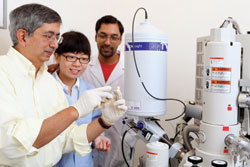A better dispersant
Can a new class of dispersants clean up oil spills without harmful side effects?
 |
| Vijay John, left, reviews oil samples with graduate students Jingjian Tang, center, and Pradeep Venkataraman. Cryo-scanning electron microscopy equipment allows scientists to understand the role of dispersants in breaking up oil. (Photo by Sabree Hill) |
Since 2010's BP oil disaster in the Gulf of Mexico, most Americans have become familiar with the term "dispersants," chemicals used to break up oil into small droplets that can be more rapidly eaten by microbes or evaporate. Concerns have been raised, however, regarding their impact on the environment.
A consortium of research institutions led by Tulane University is slated to receive a $10.34 million grant from the Gulf of Mexico Research Initiative to help develop new dispersants that more favorably balance effectiveness and toxicity in combating deep-sea drilling accidents.
The group also will study the role of dispersants and other chemical compounds in mitigating the environmental impact of deep-sea drilling accidents on the marine environment. |